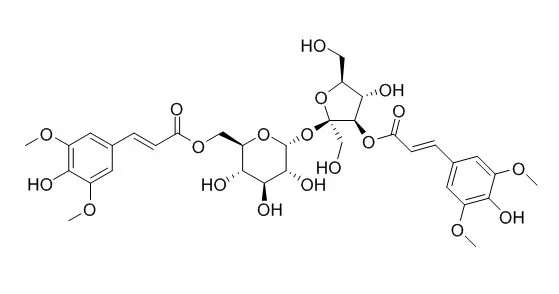| Description: |
3,6'-Disinapoyl sucrose has neuroprotective effect and antidepressive activity in rats, at least in part, by increasing expression of cyclic AMP response element (CRE)-binding protein (CREB) and its downstream target protein, brain-derived neurotrophic factor (BDNF). 3,6'-Disinapoyl sucrose protect neuron cells from glutamate-induced excitotoxicity include the downregulation of proapoptotic gene Bax and the upregulation of antiapoptotic gene Bcl-2. |
| Targets: |
cAMP | ERK | PKA | PI3K | Bcl-2/Bax | MAO | SOD | BDNF |
| In vitro: |
| J Biomed Biotechnol. 2012;2012:1-5. | | Protection of SH-SY5Y neuronal cells from glutamate-induced apoptosis by 3,6'-disinapoyl sucrose, a bioactive compound isolated from Radix Polygala.[Pubmed: 21836813] | The neuroprotective effects of 3,6'-Disinapoyl sucrose (DISS) from Radix Polygala against glutamate-induced SH-SY5Y neuronal cells injury were evaluated in the present study.
METHODS AND RESULTS:
SH-SY5Y neuronal cells were pretreated with glutamate (8 mM) for 30 min followed by cotreatment with 3,6'-Disinapoyl sucrose for 12 h. Cell viability was determined by (3,4,5-dimethylthiazol-2-yl)-2,5-diphenylte-trazolium bromide (MTT) assay, and apoptosis was confirmed by cell morphology and flow cytometry assay, evaluated with propidium iodide dye. Treatment with 3,6'-Disinapoyl sucrose (0.6, 6, and 60 μmol/L) increased cell viability dose dependently, inhibited LDH release, and attenuated apoptosis. The mechanisms by which 3,6'-Disinapoyl sucrose protected neuron cells from glutamate-induced excitotoxicity included the downregulation of proapoptotic gene Bax and the upregulation of antiapoptotic gene Bcl-2.
CONCLUSIONS:
The present findings indicated that 3,6'-Disinapoyl sucrose exerts neuroprotective effects against glutamate toxicity, which might be of importance and contribute to its clinical efficacy for the treatment of neurodegenerative diseases. | | Molecules . 2016 Oct 24;21(10):1402. | | Naturally Occurring Cinnamic Acid Sugar Ester Derivatives[Pubmed: 27783048] | | Abstract
Cinnamic acid sugar ester derivatives (CASEDs) are a class of natural product with one or several phenylacrylic moieties linked with the non-anomeric carbon of a glycosyl skeleton part through ester bonds. Their notable anti-depressant and brains protective activities have made them a topic of great interest over the past several decades. In particular the compound 3',6-disinapoylsucrose, the index component of Yuanzhi (a well-known Traditional Chinese Medicine or TCM), presents antidepressant effects at a molecular level, and has become a hotspot of research on new lead drug compounds. Several other similar cinnamic acid sugar ester derivatives are reported in traditional medicine as compounds to calm the nerves and display anti-depression and neuroprotective activity. Interestingly, more than one third of CASEDs are distributed in the family Polygalaceae. This overview discusses the isolation of cinnamic acid sugar ester derivatives from plants, together with a systematic discussion of their distribution, chemical structures and properties and pharmacological activities, with the hope of providing references for natural product researchers and draw attention to these interesting compounds.
Keywords: cinnamic acid sugar ester derivatives; pharmacological activity; phytochemistry; traditional Chinese medicine. |
|
| In vivo: |
| J Pharm Pharmacol. 2011 Jun;63(6):869-74. | | Possible mechanism of the antidepressant effect of 3,6'-disinapoyl sucrose from Polygala tenuifolia Willd.[Pubmed: 21585386] | The present study was designed to observe the effects of 3,6'-Disinapoyl sucrose (DISS), an active oligosaccharide ester component obtained from the roots of Polygala tenuifolia Willd., on behavioral and biochemical aspects of depression induced by chronic mild stress (CMS) in rats. It is the first exploration of the possible association between DISS's antidepressant-like effects and biochemical markers of depression, and involved measuring monoamine oxidase (MAO) activity, cortisol levels, superoxide dismutase (SOD) activity and malondialdehyde (MDA) levels.
METHODS AND RESULTS:
Rats were exposed to stressor once daily for consecutive 5 weeks. DISS and a positive control drug, fluoxetine, were administered via gastric intubation to once daily for consecutive 3 weeks from the third week.
The results showed that rats subjected to CMS exhibit a reduction in sucrose intake. Conversely, brain MAO-A and MAO-B activity, plasma cortisol levels, and MDA levels were increased, while SOD activity was decreased following CMS exposures. DISS significantly inhibited MAO-A and MAO-B activity and blocked plasma elevated cortisol level, an indicator of the hypothalamic-pituitary-adrenal (HPA) axis. In addition, DISS increases SOD activity, inhibits lipid peroxidation, and lessens production of MDA.
CONCLUSIONS:
These results suggest that DISS may possess potent and rapid antidepressant properties, which are mediated via MAO, the HPA axis and oxidative systems. These antidepressant actions make DISS a potentially valuable drug for the treatment of depression. |
|






 Cell. 2018 Jan 11;172(1-2):249-261.e12. doi: 10.1016/j.cell.2017.12.019.IF=36.216(2019)
Cell. 2018 Jan 11;172(1-2):249-261.e12. doi: 10.1016/j.cell.2017.12.019.IF=36.216(2019) Cell Metab. 2020 Mar 3;31(3):534-548.e5. doi: 10.1016/j.cmet.2020.01.002.IF=22.415(2019)
Cell Metab. 2020 Mar 3;31(3):534-548.e5. doi: 10.1016/j.cmet.2020.01.002.IF=22.415(2019) Mol Cell. 2017 Nov 16;68(4):673-685.e6. doi: 10.1016/j.molcel.2017.10.022.IF=14.548(2019)
Mol Cell. 2017 Nov 16;68(4):673-685.e6. doi: 10.1016/j.molcel.2017.10.022.IF=14.548(2019)